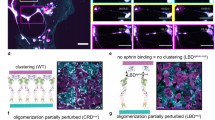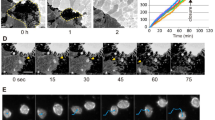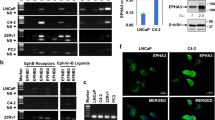Abstract
Eph receptor–ephrin signals are important for controlling repulsive and attractive cell movements during tissue patterning in embryonic development. However, the dynamic cellular responses to these signals at cell–cell contact sites are poorly understood. To examine these events we have used cell microinjection to express EphB4 and ephrinB2 in adjacent Swiss 3T3 fibroblasts and have studied the interaction of the injected cells using time-lapse microscopy. We show that Eph receptors are locally activated wherever neighbouring cells make contact. This triggers dynamic, Rac-regulated membrane ruffles at the Eph–ephrin contact sites. Subsequently, the receptor and ligand cells retract from one another, concomitantly with the endocytosis of the activated Eph receptors and their bound, full-length ephrinB ligands. Both the internalization of the receptor–ligand complexes and the subsequent cell retraction events are dependent on actin polymerization, which in turn is dependent on Rac signalling within the receptor-expressing cells. Similar events occur in primary human endothelial cells. Our findings suggest a novel mechanism for cell repulsion, in which the contact between Eph-expressing and ephrin-expressing cells is destabilized by the localized phagocytosis of the ligand-expressing cell plasma membrane by the receptor-expressing cell.
This is a preview of subscription content, access via your institution
Access options
Subscribe to this journal
Receive 12 print issues and online access
$209.00 per year
only $17.42 per issue
Buy this article
- Purchase on Springer Link
- Instant access to full article PDF
Prices may be subject to local taxes which are calculated during checkout








Similar content being viewed by others
References
Kullander, K. & Klein, R. Mechanisms and functions of Eph and ephrin signalling. Nature Rev. Mol. Cell. Biol. 3, 475–486 (2002).
Wilkinson, D.G. Multiple roles of EPH receptors and ephrins in neural development. Nature Rev. Neurosci. 2, 155–164 (2001).
Batlle, E. et al. β-catenin and TCF mediate cell positioning in the intestinal epithelium by controlling the expression of EphB/ephrinB. Cell 111, 251–263 (2002).
Adams, R.H. & Klein, R. Eph receptors and ephrin ligands: Essential mediators of vascular development. Trends Cardiovasc. Med. 10, 183–188 (2000).
Dodelet, V.C. & Pasquale, E.B. Eph receptors and ephrin ligands: embryogenesis to tumorigenesis. Oncogene 19, 5614–5619 (2000).
Hattori, M., Osterfield, M. & Flanagan, J.G. Regulated cleavage of a contact-mediated axon repellent. Science 289, 1360–1365 (2000).
Carter, N., Nakamoto, T., Hirai, H. & Hunter, T. EphrinA1-induced cytoskeletal re-organization requires FAK and p130(cas). Nature Cell Biol. 4, 565–573 (2002).
Miao, H., Burnett, E., Kinch, M., Simon, E. & Wang, B. Activation of EphA2 kinase suppresses integrin function and causes focal-adhesion-kinase dephosphorylation. Nature Cell Biol. 2, 62–69 (2000).
Hall, A. & Nobes, C.D. Rho GTPases: molecular switches that control the organization and dynamics of the actin cytoskeleton. Phil. Trans. R. Soc. Lond. B 355, 965–970 (2000).
Ridley, A.J. Rho GTPases and cell migration. J. Cell Sci. 114, 2713–2722 (2001).
Shamah, S.M. et al. EphA receptors regulate growth cone dynamics through the novel guanine nucleotide exchange factor ephexin. Cell 105, 233–244 (2001).
Wahl, S., Barth, H., Ciossek, T., Aktories, K. & Mueller, B.K. Ephrin-A5 induces collapse of growth cones by activating Rho and Rho kinase. J. Cell Biol. 149, 263–270 (2000).
Irie, F. & Yamaguchi, Y. EphB receptors regulate dendritic spine development via intersectin, Cdc42 and N-WASP. Nature Neurosci. 5, 1117–1118 (2002).
Penzes, P. et al. Rapid induction of dendritic spine morphogenesis by trans-synaptic ephrinB-EphB receptor activation of the Rho-GEF kalirin. Neuron 37, 263–274 (2003).
Holmberg, J., Clarke, D.L. & Frisen, J. Regulation of repulsion versus adhesion by different splice forms of an Eph receptor. Nature 408, 203–206 (2000).
Weinl, C., Drescher, U., Lang, S., Bonhoeffer, F. & Loschinger, J. On the turning of Xenopus retinal axons induced by ephrin-A5. Development 130, 1635–1643 (2003).
Pyenta, P.S., Holowka, D. & Baird, B. Cross-correlation analysis of inner-leaflet-anchored green fluorescent protein co-redistributed with IgE receptors and outer leaflet lipid raft components. Biophys. J. 80, 2120–2132 (2001).
Litman, P., Amieva, M.R. & Furthmayr, H. Imaging of dynamic changes of the actin cytoskeleton in microextensions of live NIH3T3 cells with a GFP fusion of the F-actin binding domain of moesin. BMC Cell Biol. 1, 1 (2000).
Machesky, L.M. & Insall, R.H. Scar1 and the related Wiskott–Aldrich syndrome protein, WASP, regulate the actin cytoskeleton through the Arp2/3 complex. Curr. Biol. 8, 1347–1356 (1998).
Uehata, M. et al. Calcium sensitization of smooth muscle mediated by a Rho-associated protein kinase in hypertension. Nature 389, 990–994 (1997).
Gerety, S.S., Wang, H.U., Chen, Z.F. & Anderson, D.J. Symmetrical mutant phenotypes of the receptor EphB4 and its specific transmembrane ligand ephrin-B2 in cardiovascular development. Mol. Cell 4, 403–414 (1999).
Wang, H.U., Chen, Z.F. & Anderson, D.J. Molecular distinction and angiogenic interaction between embryonic arteries and veins revealed by ephrin-B2 and its receptor Eph-B4. Cell 93, 741–753 (1998).
Kim, I. et al. EphB ligand, ephrinB2, suppresses the VEGF- and angiopoietin 1-induced Ras/mitogen-activated protein kinase pathway in venous endothelial cells. FASEB J. 16, 1126–1128 (2002).
Jurney, W.M., Gallo, G., Letourneau, P.C. & McLoon, S.C. Rac1-mediated endocytosis during ephrin-A2- and semaphorin 3A-induced growth cone collapse. J. Neurosci. 22, 6019–6028 (2002).
Jin, Z. & Strittmatter, S.M. Rac1 mediates collapsin-1-induced growth cone collapse. J. Neurosci. 17, 6256–6263 (1997).
Kuhn, T.B., Brown, M.D., Wilcox, C.L., Raper, J.A. & Bamburg, J.R. Myelin and collapsin-1 induce motor neuron growth cone collapse through different pathways: inhibition of collapse by opposing mutants of rac1. J. Neurosci. 19, 1965–1975 (1999).
Vastrik, I., Eickholt, B.J., Walsh, F.S., Ridley, A. & Doherty, P. Sema3A-induced growth-cone collapse is mediated by Rac1 amino acids 17–32. Curr. Biol. 9, 991–998 (1999).
Deroanne, C., Vouret-Craviari, V., Wang, B. & Pouyssegur, J. EphrinA1 inactivates integrin-mediated vascular smooth muscle cell spreading via the Rac/PAK pathway. J. Cell Sci. 116, 1367–1376 (2003).
Van Vactor, D.L. Jr, Cagan, R.L., Kramer, H. & Zipursky, S.L. Induction in the developing compound eye of Drosophila: multiple mechanisms restrict R7 induction to a single retinal precursor cell. Cell 67, 1145–1155 (1991).
Cagan, R.L., Kramer, H., Hart, A.C. & Zipursky, S.L. The bride of sevenless and sevenless interaction: internalization of a transmembrane ligand. Cell 69, 393–399 (1992).
Kramer, H. & Phistry, M. Mutations in the Drosophila hook gene inhibit endocytosis of the boss transmembrane ligand into multivesicular bodies. J. Cell Biol. 133, 1205–1215 (1996).
Klueg, K.M. & Muskavitch, M.A. Ligand–receptor interactions and trans-endocytosis of Delta, Serrate and Notch: members of the Notch signalling pathway in Drosophila. J. Cell Sci. 112, 3289–3297 (1999).
Incardona, J.P. et al. Receptor-mediated endocytosis of soluble and membrane-tethered Sonic hedgehog by Patched-1. Proc. Natl Acad. Sci. USA 97, 12044–12049 (2000).
Bailey, C.H., Chen, M., Keller, F. & Kandel, E.R. Serotonin-mediated endocytosis of apCAM: an early step of learning-related synaptic growth in Aplysia. Science 256, 645–649 (1992).
Lamarche, N. et al. Rac and Cdc42 induce actin polymerization and G1 cell cycle progression independently of p65PAK and the JNK/SAPK MAP kinase cascade. Cell 87, 519–529 (1996).
Symons, M.H. & Mitchison, T.J. Control of actin polymerization in live and permeabilized fibroblasts. J. Cell Biol. 114, 503–513 (1991).
Zimmer, M., Palmer, A., Köhler, J. & Klein, R. EphB–ephrinB bi-directional endocytosis terminates adhesion allowing contact mediated repulsion. Nature Cell Biol. 5, DOI: 10.1038/ncb1045 (2003).
Acknowledgements
We thank R. Klein for sharing unpublished results. We also thank R. Adams, D. Wilkinson, M. Henkemeyer, C. Cowan, D. Holowka, L. Machesky, M. Furthmayr and J. M. Edwardson for cDNAs and expression constructs; J. Pendjiky, D. Ciantar and M. Shipman for help with image acquisition and processing; P. Martin and M. Raff for valuable comments on the manuscript, and members of the Nobes laboratory for advice and helpful discussions. This work was inspired by the late Nigel Holder and was supported by the Medical Research Council. C.D.N. is an MRC Senior Research Fellow.
Author information
Authors and Affiliations
Corresponding author
Ethics declarations
Competing interests
The authors declare no competing financial interests.
Rights and permissions
About this article
Cite this article
Marston, D., Dickinson, S. & Nobes, C. Rac-dependent trans-endocytosis of ephrinBs regulates Eph–ephrin contact repulsion. Nat Cell Biol 5, 879–888 (2003). https://doi.org/10.1038/ncb1044
Received:
Accepted:
Published:
Issue Date:
DOI: https://doi.org/10.1038/ncb1044
This article is cited by
-
Ephrin-B2–EphB4 communication mediates tumor–endothelial cell interactions during hematogenous spread to spinal bone in a melanoma metastasis model
Oncogene (2020)
-
The endosomal sorting adaptor HD-PTP is required for ephrin-B:EphB signalling in cellular collapse and spinal motor axon guidance
Scientific Reports (2019)
-
Long-lived force patterns and deformation waves at repulsive epithelial boundaries
Nature Materials (2017)
-
EphA5 and EphA6: regulation of neuronal and spine morphology
Cell & Bioscience (2016)
-
Design principles for therapeutic angiogenic materials
Nature Reviews Materials (2016)



